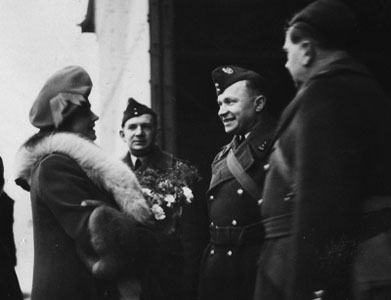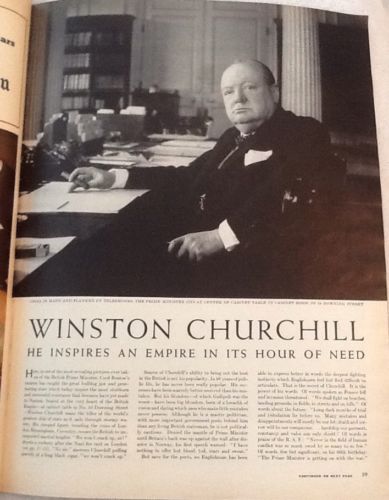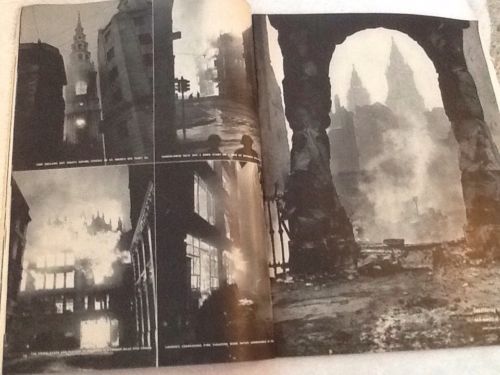Monday 27 January 1941
 |
| "Hampden Mark II, X3115, at the Aeroplane and Armament Experimental Establishment, Boscombe Down, Wiltshire, January 1941. X3115 later saw service as a torpedo bomber with No. 415 Squadron RCAF." © IWM (MH 4642). |
The Italian government, sensing a possible inflection point in the winter battles due to some minor recent tactical successes, pulls a motivational trick they have done before, both in earlier campaigns such as Ethiopia and also in Albania. Top government officials such as Foreign Minister Count Galeazzo Ciano travel to Albania to take up active military commands. Ciano, an experienced bomber pilot, takes over a bomber squadron. It is unclear if this is intended more to boost the morale of the troops on the ground in Albania, boost the morale/enthusiasm of the ministers, punish the ministers, or perhaps all three.
The Italians bomb Argyrokastro, causing over 500 casualties.
East African Campaign: The Indian 4th and 5th Divisions close on Agordat. They send a brigade to the south in order to begin a flanking move around the Italian position. General Orlando Lorenzini waits there for the Indian troops with 76 artillery pieces and his 4th Colonial Division. The Indian 4th Division attacks Lorenzini's forces and is repulsed. Other Indian brigades attack Barentu. The RAF bombs various points in the region, but they have little effect on the tactical situation.
 |
| Queen Elizabeth visiting RAF Seyrston, home of two Polish bomber squadrons. Wing Commander Jankowski of RAF No. 305 Squadron and Wing Commander Dudzinski of No. 304 are presenting Her Majesty with flowers. January 27, 1941. |
RAF Bomber Command attacks Hanover, one of many, many raids which batter this city throughout the war.
British Prime Minister Winston Churchill sends a memo to Sir Archibald Sinclair, Secretary of State for Air, and Hugh Dalton, Minister of Economic Warfare, with some suggestions for the air campaign. He notes:
There must be a very great deal of railway traffic from Germany to Italy; coal alone should account for nearly 200,000 tons a week averaged over the year. It is obviously most important that this should be impeded in every way.Actually, it is not at all obvious that the RAF should attempt to disrupt the coal shipments at this time. Churchill's blocking the coal shipments to Italy earlier in the war via the English Channel simply forced the shipments to be made by rail over the Alps, a much more secure route. That action also likely inflamed Italian public opinion against Great Britain. RAF Bomber Command has many high priority targets, and the rail lines over the Alps are difficult to disrupt (requiring precision bombing at the extreme range of current RAF bombers). This is another example of Churchill meddling in the military commands to little purpose.
 |
| The Ringwall, sunk today by a mine. |
Royal Navy minesweeping trawler HMT Darogah hits a mine and sinks in the Thames Estuary.
British 407-ton coaster Ringwall hits a mine laid by a Kriegsmarine minelaying U-boat and sinks south of the Isle of Man in the Irish Sea. Casualties are unknown, but generally few would survive a mine strike in such a small (143 ft long) craft.
British 73-ton barge Hedon sinks from unknown causes, perhaps a mine.
Convoy FN 393 departs from Southend, Convoy FS 397 departs from Methil, Convoy FS 398 is canceled, Convoy HG 52 departs from Gibraltar.
Royal Navy corvette HMS Azalea (K 25, Commander Lt. George C. Geddes) is commissioned, minesweeping trawler HMS Fara is launched.
U-371 is launched, U-599 is laid down.
False reports circulate that converted troopship HMS Empress of Australia has been torpedoed and sunk off the coast of Africa. It turns out to be just a rumor and the ship is fine.
 |
| "Stukas New Menace in the Mediterranean," Newsweek Magazine, 27 January 1941. |
However, the British are building up their forces, and the Italian command is gradually peeling away their troops in fear of losing them like so many other troops in Egypt and eastern Libya. Having beaten the Babini Group armor back into Mechili, the 11th Hussars slides around the fortress to the right at Chaulan, between Mechili and Derna. This threatens the Italians at Derna with encirclement. General Annibale Bergonzoli loses his nerve and orders his troops defending Derna to begin preparing to retreat.
The Italian troops continue their suddenly effective conduct by harassing the advancing British at Derna and conducting a scorched earth policy by blowing holes and roads and waylaying the advancing Australians. They remain a strong presence at the northern edge of Wadi Derna near the city. However, the Australian 2/11 Battalion takes the key high ground at Fort Rudero above Derna, capturing five guns and 290 prisoners.
At Mechili, the Babini Group armor has fled, and the British 7th Armoured Division takes possession of the fortress. The British decide to stop and consolidate their position there before heading toward Benghazi.
The British supply situation in Libya is strained. It gets the prospect of relief today when the Royal Navy completes its minesweeping of Tobruk Harbor and the clearing of wrecks and opens it for use. Troopship Ulster Prince arrives to take on the Italian prisoners, while three freighters arrive with supplies. An old nemesis - not the Italians - interferes with the operations there: sandstorms.
The Fairey Swordfish of RAF No. 830 Squadron, operating out of Malta since the crippling of HMS Illustrious, sink 3950-ton German freighter Ingo off Cape Bon, Tunisia. The survivors are rescued by Italian torpedo boat Orione.
Italian torpedo boat Francesco Stocco hits a mine in the Adriatic off Sansego, Yugoslavia which literally cuts it in half. The two separate halves somehow remain afloat and are towed to Rijeka. There, they are welded back together and the ship returns to service.
 |
| Winston Churchill profiled in Life Magazine, 27 January 1941. |
Spy Stuff: Peruvian Minister to Japan Ricardo Rivera-Schreiber warns US Ambassador to Japan Joseph Grew about a rumor he has heard at a diplomatic reception. It concerns a coming Japanese assault on Pearl Harbor. Grew swiftly cables Washington that:
My Peruvian colleague told a member of my staff that he had heard from many sources including a Japanese source that the Japanese military forces planned, in the event of trouble with the United States, to attempt a surprise base attack on Pearl Harbor using all of their military facilities. He added that although the project seemed fantastic the fact that he heard it from many sources prompted him to pass on the informationThis information is provided to both Admiral Harold R. Stark, Chief of Naval Operations and Admiral Husband Kimmel, Commander-in-chief of the U.S. Pacific Fleet. They shrug it off. This type of information will be reviewed with great intensity in 1942 and thereafter. Kimmel, in particular, will have great cause to regret his own blasé attitude. However, this attitude is common around the world, as Joseph Stalin similarly discounted warnings at the end of December 1940 from his spy in Tokyo, Richard Sorge.
 |
| "Barron von Werra Begins Tour of 'Sights' After Arrival In New York City." Ogdensburg Journal, 27 January 1941. |
British Military: The prototype Avro Lancaster bomber (apparently still referred to as a type 683 Manchester Mk III with serial No. BT308) is flown from Woodford, where it made its first test flights, to Boscombe Down. There, the Aircraft and Armament Experimental Establishment (A&AEE) intends to swap in Rolls Royce Merlin X engines. Everybody is very excited about the huge improvements so far over the disappointing Manchester.
 |
| "This is the World's Great City of Lights," apparently New York City (all the others are blacked out), Life Magazine, 27 January 1941. |
US Military: Admiral Stark shifts some of his ground forces around, sending the 3rd Defense Battalion of the US Marines to Midway, the 1st Defense Battalion to Johnston and Palmyra, and the 6th Defense Battalion to Pearl Harbor.
 |
| "Winston Churchill II and Mother," Life Magazine, 27 January 1941. The baby is Winston Spencer-Churchill (10 October 1940 – 2 March 2010), son of Randolph Churchill and Pamela Digby (pictured). |
[T]he plan is difficult but not impossible.Yamamoto, meanwhile, turns over the planning to Rear Admiral Ryunosuke Kusaka, who is more worried about the Pearl Harbor anti-aircraft defenses. Genda then suggests that the torpedo problem is fixable and that, to diminish the effectiveness of US defenses, the attack should be made by aircraft carriers parked off the coast and conducted early in the morning. There are other issues, such as the fact that the US fleet would be sunk in shallow water and thus could be salvaged, with minimal loss of life, but Yamamoto is satisfied that the attack can be conducted. While not yet given a code name, this operation will proceed as Operation Z.
Japanese Government: Japanese Foreign Minister Matsuoka Yosuko addresses a secret session of the Diet:
Has America any right to object if Japan does dominate the Western Pacific?.... We must control the Western Pacific.He warns, basically, that if the US does not repent its past attitude toward Japan, which has resulted in sanctions and attempted diplomatic intimidation, that bad thing will happen (which he does not specify).
Vichy France: According to new Articles 2 and 3 of constitutional act number 7, all "high functionaries"must now swear an oath of allegiance to Marshal Petain. This applies to magistrates and teachers but is not applicable to private lawyers. Anyone found "unfaithful to his obligations" can be sent to camps.
 |
| London Blitz pictures, Life Magazine, 27 January 1941. |
Hitler, however, also likes to keep his options open, so he has granted political asylum to Iron Guard leader Horia Sima - who Antonescu has had sentenced to death. The Iron Guard members prove useful to the Germans due to their extreme anti-Semitism, and they find gainful employment as camp guards at places like Buchenwald and Dachau.
Antonescu, meanwhile, now obviously has lost the temporary support of the main branch of the Iron Guard led by Sima. He moves to secure the support of some splinter groups of the Iron Guard who had opposed Sima for various reasons. The Codrenists, for instance, become his key ally. They are named for their leader Ion Zelea Codreanu, the father of the deceased Iron Guard founder who views Sima as a usurper to his son's movement. However, Antonescu has difficulty winning the support of more moderate political groups in the country, and from this point forward his regime is basically becomes a military dictatorship with no claims to legitimacy within an elected government.
Latin America: The countries of South America begin a conference on economic cooperation at Montevideo.
China: At the Battle of Southern Honan, the Japanese 11th Army continues its offensive. It captures several towns abandoned by the Chinese, including Chunshui, Shahotien, Chumatien, and Junnan.
2020
No comments:
Post a Comment